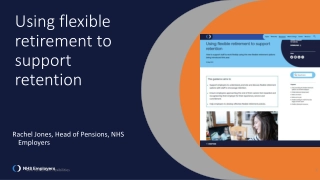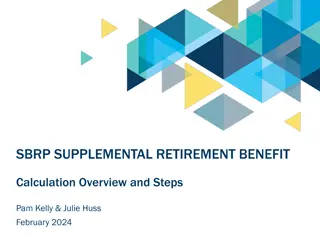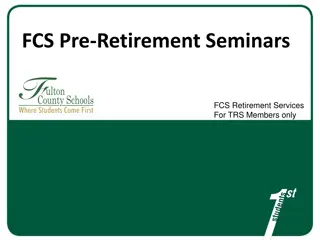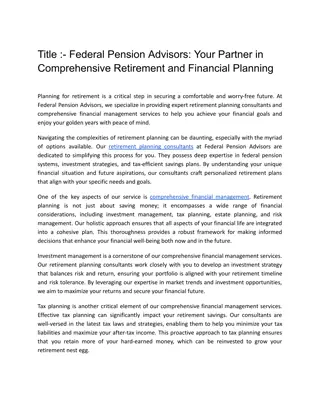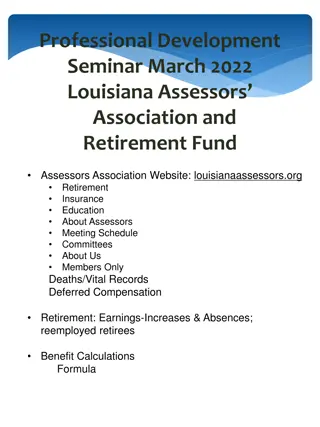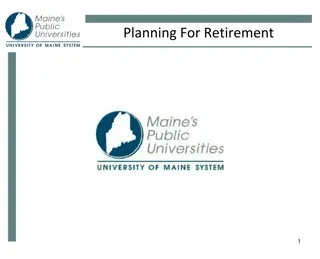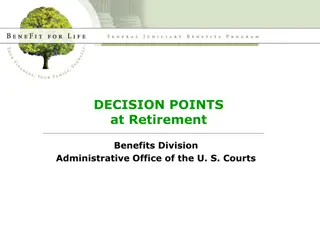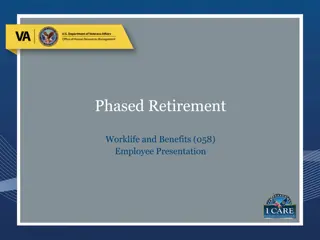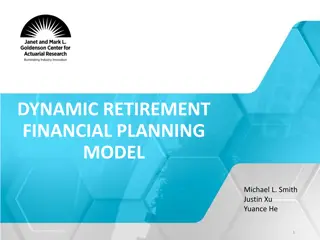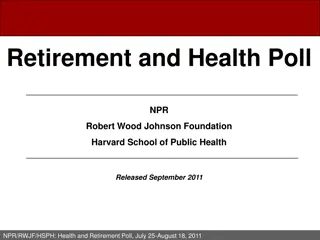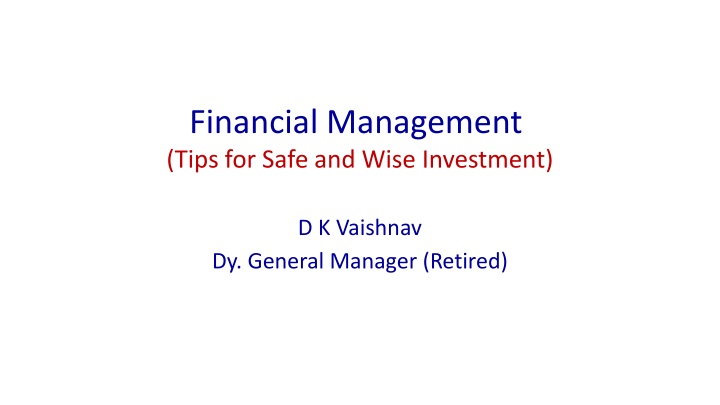
Financial Management Tips for Safe and Wise Investment by D.K. Vaishnav
Learn valuable insights on financial management, especially on safe and wise investments, from D.K. Vaishnav, a retired General Manager. Discover essential preparation steps, benefits to consider, and the importance of staying updated with technology for secure banking.
Download Presentation

Please find below an Image/Link to download the presentation.
The content on the website is provided AS IS for your information and personal use only. It may not be sold, licensed, or shared on other websites without obtaining consent from the author. If you encounter any issues during the download, it is possible that the publisher has removed the file from their server.
You are allowed to download the files provided on this website for personal or commercial use, subject to the condition that they are used lawfully. All files are the property of their respective owners.
The content on the website is provided AS IS for your information and personal use only. It may not be sold, licensed, or shared on other websites without obtaining consent from the author.
E N D
Presentation Transcript
Financial Management (Tips for Safe and Wise Investment) D K Vaishnav Dy. General Manager (Retired)
Backdrop Most of us have, probably, not handled amount equal to what we are likely to get at the time of superannuation It is a most dangerous area and proposition to guide people in this respect because no one can make absolutely correct predictions about safety of/return on investments It is subject to market risks With many dimensions like Yet, there is room for some basic inputs/information It can help in developing a meaningful base and insight Experience sharing by someone who has gone through this phase may make some value addition
Preparation Preparation essentially has two steps - To know the amount at hand and issues involved How and where to invest Homework for first step List out Headings under which you are likely to get money To find out the quantum of amount under each heading and try to understand the working of the amount we are likely to receive under various headings/ study copy of the relevant scheme/circular Understand deductions/calculations like Housing loan, Car loan etc. Income-tax implication You should not pay for lack of knowledge of someone who is handling terminal benefits in the office/department
Preparation List of benefits and formalities to be completed Pension papers and working Follow up for NOC from all the departments Decision to retain or return the equipment like laptop, mobile etc. Car transfer particularly from one state to another Surrender/Extension of Company accommodation Car perquisite valuation working Telephone (landline) surrender LTS extension request Clearance of pending payments like Telephone, Tour, Newspaper etc.
Preparation Keep yourself updated with ever advancing technology Online SAFE banking Creation/Regular change of Pin Learn to avoid online traps, example reversal of wrong credit in Bank a/c, Sharing some OTP, clicking on some link etc. Tempting e-mails Tempting click options on the screen like free this and free that Learn to file your own I T return Easier to learn while in office reverse mentoring (young officers)
Preparation Financial oWhen you get money in your account don t allow it to remain there for a day even oRisk of borrowing requests by relatives, temptation of buying something not really required oBank Accounts with large amounts (particularly sudden) are targets of frauds oFollow two accounts theory oKeep blue print of investment ready and transfer the money immediately oIf you are going for FDs spread it over many banks in view of 1/5 lac limit oNomination oMake Will-difference between nomination and legal heir oAll passwords and pins note down and keep with your spouse, in case ..
Preparation Step 2 How and Where to invest For this we need to have clarity of mind as to what is our priority- Return Rate as well as mode (Regular income or Capital gain) Net of inflation and income tax Liquidity depends upon pending family responsibilities like marriage of son/daughter, purchasing/building house, Children studies etc. Risk Appetite Risk and return moves in direct proportion higher the gain, higher the risk and lower the gain, lower the risk While selecting an investment avenue, you have to match your own risk profile/capacity with the associated risks of the product before investing. Income-Tax saving
Preparation Step 2 There are 2 buckets that investment products fall into i.e. financial and non-financial assets. Financial assets can be divided into - market-linked products (such as stocks and mutual fund) and fixed income products (like Public Provident Fund, bank fixed deposits). Non-financial assets - many Indians invest via this mode, they are the likes - Physical gold and Real estate.
Preparation Step 2 The best way is to go for combination (risk, return and liquidity) and distribute your investment accordingly Before you actually get the money in your bank account, you should have clarity as to how much you wish to invest in which scheme/avenue Keep the respective forms duly filled up and ready Don t allow the money to remain idle in your bank account for more than a day or two safety (cyber, borrowing and impulse to buy something really not required) and return consideration
Options Now, that all of us have pension facility, to meet our day to day expenses, we may not focus more on regular income investments unless someone has this need . as an exception So we can afford to direct our investments towards wealth creation (appreciation) like mutual funds, equities Then other aspect like Senior Citizen Schemes Fixed income Options Growth or wealth creation options Combination of both Time lines for withdrawals i.e. liquidity
Senior Citizen Investment Schemes Pradhan Mantri Vaya Vandana Yojana The PMVVY scheme operated by the LIC is a low-risk investment plan. It has a tenure of 10 years and it offers an interest rate of 7.4%. However, only senior citizens can make a lump-sum investment - minimum investment of Rs. 1.56 lakh and maximum Rs. 15 lakh The income receivable under the scheme ranges from Rs. 1,000 to Rs. 10,000 per month depending on the amount you have invested. Keep in mind that investment made towards this scheme will not be eligible for tax deductions under Section 80C.
Senior Citizen Investment Schemes Senior Citizen Savings Scheme (SCSS) SCSS is a good long-term investment option for senior citizens. You can avail of the scheme from post offices and recognised banks. You can invest a maximum amount of Rs. 15 lakhs. It offers an interest rate of 7.4% which is comparatively higher than other savings schemes and fixed deposits You also get tax benefits up to Rs. 1.5 lakh per year under Section 80C of the IT Act, 1961. SCSS has a maturity period of five years with an extension of three years. for Q1 FY 2021-22.
Investment options for growth There are various types of investments through which senior citizens can orient their portfolios towards growth and wealth accumulation. Let us look at some of the investments options inflation- beating returns While availing this option, you need to have some knowledge about financial market and up-dation on regular basis It would be risky to completely depend upon others/tips.
Investment options for growth Common Psyche Be careful Most investors want to make investments in such a way that they get sky-high returns as quickly as possible without the risk of losing principal money. This is the reason why many are always on the lookout for top investment plans (tips) where they can double their money in few months or years with little or no risk. However, high-return, low-risk combination in a investment product, unfortunately, does not exist .its more of a fiction or fraud In reality, risk and returns are directly related, they go hand-in-hand, i.e. the higher the returns, higher the risk and vice versa.
Investment options for growth Direct Equity/Stock Investment in equities is through Capital Market - primary market (IPOs)& Secondary market This option offers higher, higher than inflation-adjusted returns compared to all other asset classes, over long period but then PayTM like fiasco also happens At the same time, the risk of losing a considerable portion or even all of your capital is high unless one opts for stop-loss method to curtail losses To reduce the risk to certain extent, you could diversify across sectors and market capitalisations.
Investment options for growth Investing in stocks might not be everyone's cup of tea as it's a volatile asset class and there is no guarantee of returns. Further, not only it is difficult to pick the right stock, timing your entry and exit is also not easy. To directly invest in equity, one needs to open a de-mat account. The returns (dividends or capital gain) are subject to income-tax though there is some tax benefit on dividend income We need to have good market research about performance of the companies particularly those in which you have invested
Investment options for growth Equity Mutual Funds Investment in mutual funds is one of the options to build wealth over some time particularly when you don t have deep knowledge and understanding of capital market. You can have twin benefits of Inflation-beating returns and tax savings but, at the same time, you are subject to market risks You can invest in ELSS, a special category of mutual fund that qualifies for Section 80C tax deduction, up to Rs. 1.5 lakh per year. ELSS is an equity linked savings scheme with a lock-in period of three years. This investment can be done through SIP also.
Investment options for growth Debt Mutual Funds Debt mutual fund schemes are suitable for investors who want steady returns. They are less volatile and, hence, considered less risky compared to equity funds. Debt mutual funds primarily invest in fixed-interest generating securities like corporate bonds, government securities, treasury bills, commercial paper and other money market instruments. However, these mutual funds are not risk free. They carry risks such as interest rate risk and credit risk.
Investment options for growth National Pension Scheme (NPS) This scheme can be availed by individuals between the ages of 18 and 65 years. Senior citizens can extend the tenure up to 70 years of age as well. Under Section 80C, taxpayers are eligible for deductions up to Rs. 1.50 lakh per year on the investment made towards NPS. Similarly, under Section 80CCD, individuals are also eligible for additional tax benefits up to Rs. 50,000 a year. The investment made towards the NPS can be directed towards equity, corporate and government securities, depending on the individuals choice under the active option. However, you also can opt for the auto choice where asset allocation happens based on your age. Though NPS does not offer a steady interest income, the scheme generates returns and your investment can grow at a faster rate by orienting your NPS towards equity funds. However, the maximum NPS investment in equity is capped at 75%.
Investment options - Fixed Income Bank fixed deposit Bank fixed deposits have always been a popular source of regular income. Depending on the bank and tenure, currently, the interest rate is around 5 to 6 per cent p.a. across most tenures. Deposits are insured up to a maximum of Rs.5 lakh for all bank deposits, such as saving, fixed, current, recurring deposits under the Deposit Insurance and Credit Guarantee Corporation Act, 1961.
Investment options - Fixed Income Post Office Time Deposit Account (TD) The time deposit (TD) in a post office is somewhat similar to a bank fixed deposit. While the time deposits in a post office are for 1, 2 , 3 and 5 years, its only the 5-year TD that comes with section 80C tax benefit. There is no maximum limit but yearly tax benefit is restricted to Rs. 1.5 lakh Interest earned is fully taxable and to be added to one s Income from other sources . There s only the annual interest option as it does not allow monthly or cumulative options. Currently, the interest rate on 5 year TD is 6.7 per cent per annum, payable annually but calculated quarterly.
Investment options - Fixed Income POMIS Retirees could invest a portion of the retirement fund in the post office monthly income scheme (POMIS). It is a government-backed scheme that offers a higher interest rate than bank FDs (6.6%, at present) and has a lock-in period of 5 years. Retired people may invest a maximum of Rs.4.5 lakh individually, or Rs.9 lakh jointly, in POMIS. It is suitable for investors who seek fixed monthly income and are unwilling to take a risk in their investments. However, interest pay outs are taxable and lower returns for those in the higher income tax brackets.
Investment options - Fixed Income Government Securities Government Securities are also backed by the government and hence 100 per cent safe to investors. Government Securities are risk-free instruments and help in providing portfolio diversification and are available for longer investment durations. Retail investors can invest in Government Securities under the non- competitive bidding in Government of India Dated Securities (G-Sec) and Treasury Bills (T-Bills). Retail investors can place their bids through trading members of NSE or using the NSE goBID mobile app or web platform. The minimum amount for bidding will be Rs.10,000 (face value) and in multiples of Rs.10,000. Although any exit before maturity may result in capital gain or loss, the investment if held till maturity is safe as it is backed by the government.
Investment options - Fixed Income Floating Rate Savings Bonds 2022 (Taxable) Floating Rate Savings Bonds 2021 (Taxable) comes with 100 per cent guarantee as they are government-backed investments. One can invest through branches of State Bank of India, Nationalised Banks and four specified private sector banks. They have a tenure of 7 years and the interest rate will keep varying during the tenure of the scheme. The rate of interest was set at 7.15 per cent per annum payable half- yearly. The minimum investment amount is Rs.1000, while there will be no maximum limit for investments made in the Bonds. The maximum investment in cash can be made up to Rs.20,000.
Investment options fixed income RBI Taxable Bonds Earlier, RBI used to issue 7.75% (fixed) Savings (Taxable) Bonds as an investment option. However, the central bank has stopped issuing these bonds with effect from May 29, 2020. The Central Bank with effect from July 1, 2020 has launched Floating Rate Savings Bond, 2020 (Taxable). The biggest difference between earlier 7.75% savings bonds and the newly launched floating rate bond is that the interest rate on the newly launched savings bond is subject to reset in every six months. In the 7.75% bonds, the interest rate was fixed for the entire duration of the investment. Currently, the bonds are offering interest rate of 7.15%.
Investment options - Fixed Income Immediate Annuities Immediate Annuity schemes suit those who wish to have a regular source of income till lifetime no matter which way the interest rate moves. Immediate Annuity scheme can provide a regular base-level income and, therefore, one may consider investing some portion of the savings into it. There are about 7-10 different pension options, including pension for a lifetime for self, after death to spouse and post that the return of corpus to heirs. Currently, the pension or the annuity is around 5-6 per cent per annum and is entirely taxable as per one s income slab.
Investment options Growth & Fixed Income Sovereign Gold Bonds Unlike in the past when gold was only considered a hedge against inflation and held entirely in physical form, today it finds its place even in an investor's portfolio and largely as paper gold. Earlier as gold exchange traded funds (Gold ETFs) and now as Sovereign Gold Bonds (SGBs), paper gold offers many advantages to Indian investors now. Window of opportunity The bonds will not be available all year round. The government will keep coming out with primary issue of different tranches of SGBs for open purchase .every 2-3 months and the window will remain open for about a week. ( SGB IX - 10thJan. to 14thJan. 2022..Rs.4,786/- per gram) For investors looking to purchase SGBs between two such primary issues, the only way out is to buy earlier issues (at market value) which are listed in the secondary market. The biggest advantage of SGBs is clearly on the tax front. The 2016-17 Budget had proposed that the redemption of the bonds by an individual be exempt from the capital gains tax. Therefore, holding till maturity has its tax advantage. Redeeming in stock exchange may, however, result in capital gains or loss and one may have to pay tax accordingly. Interest on the bonds is, however, fully taxable as per the tax rate of an investor.
Investment options Tax benefit Public Provident Fund (PPF) PPF is a long term investment and requires a regular contribution to be paid for 15 years. One may, however, exit after 5 years ( subject to conditions), avail a loan from 4th year and make partial withdrawals after 7th year. As per the rules, one is allowed to open only one account in own name while another can be opened in a minor child s name. A minimum of Rs. 500 and maximum of Rs. 1.5 lakh ( self plus minor account) in each financial year can be put into the PPF scheme. While the investment qualifies for tax benefit under Section 80C, the interest earned is tax-exempt. Post maturity, the PPF account can be extended indefinitely in a block of five years.
Investment options Tax benefit National Savings Certificate (NSC) NSC requires only a lump sum payment for a period of five years and there is no need to pay further contributions. On maturity, a fixed amount is received which is known right at the time of investment. NSC is issued in denominations of Rs. 100, Rs. 500, Rs.1000, Rs.5000, Rs.10,000. The interest is fully taxable but importantly interest is reinvested for the initial four years and also qualifies for Section 80C benefit. Currently, the interest rate on NSC is 6.8 percent per annum, compounded annually and paid on maturity.
Investment options Tax benefit Kisan Vikas Patra (KVP) Available only at post offices, the KVP certificate can be purchased by an adult for himself or on behalf of a minor or by two adults. The minimum amount of KVP is Rs. 1,000 while there is no maximum limit. There is a provision to transfer KVP from one person to another and from one post office to another. At the time of need, the KVP certificates may be encashed anytime after 2 and half years from the date of purchasing it. Currently, the KVP carries a return of 6.9 per cent compounded annually. The amount invested doubles in 124 months and interest along with capital is paid only on maturity.
Investment options Non-financial Assets Real Estate This investment includes land (agricultural as well as residential), flats, houses, shops, offices, houses The location of the property is the most important factor that will determine the value of your property and also the rental that it can earn. Investments in real estate deliver returns in two ways - capital appreciation and rentals. However, unlike other asset classes, real estate is highly illiquid. There is income-tax benefit also
Investment options Non-financial Assets Gold Investment in gold (physical form) is an age old traditional option, mostly favourite of Indian women Possessing gold in the form of jewellery has its own concerns such as safety, purity and high cost. Then there's the 'making charges', which typically range between 6- 14 per cent of the cost of gold (and may go as high as 25 percent in case of special designs). For those who would want to buy gold coins, there's still an option. Many banks sell gold coins now-a-days.
Homework 1. Window of opportunity 2. How much to invest 3. Time horizon 4. Return 5. Tax advantage 6. Suitability 7. Approach 8. Liquidity requirement 9. Risk Appetite

